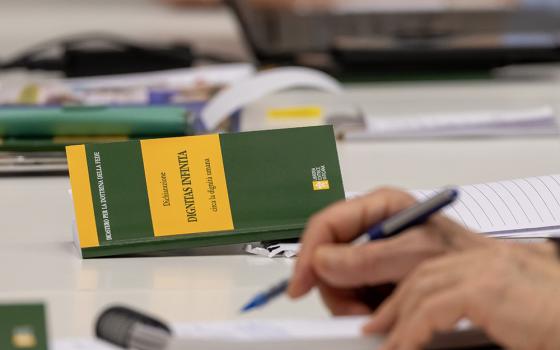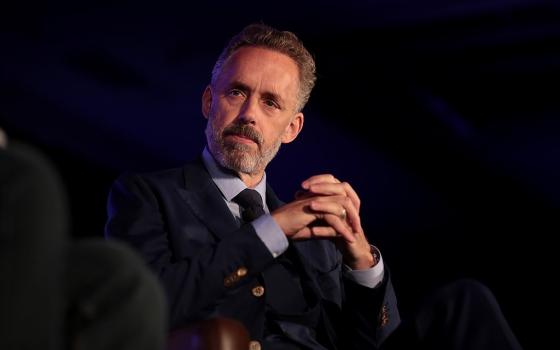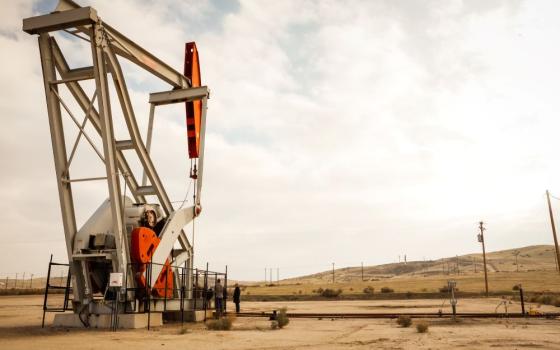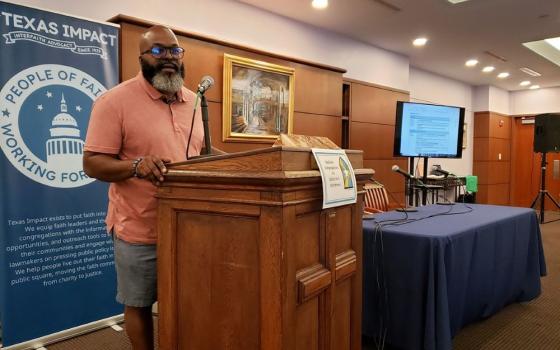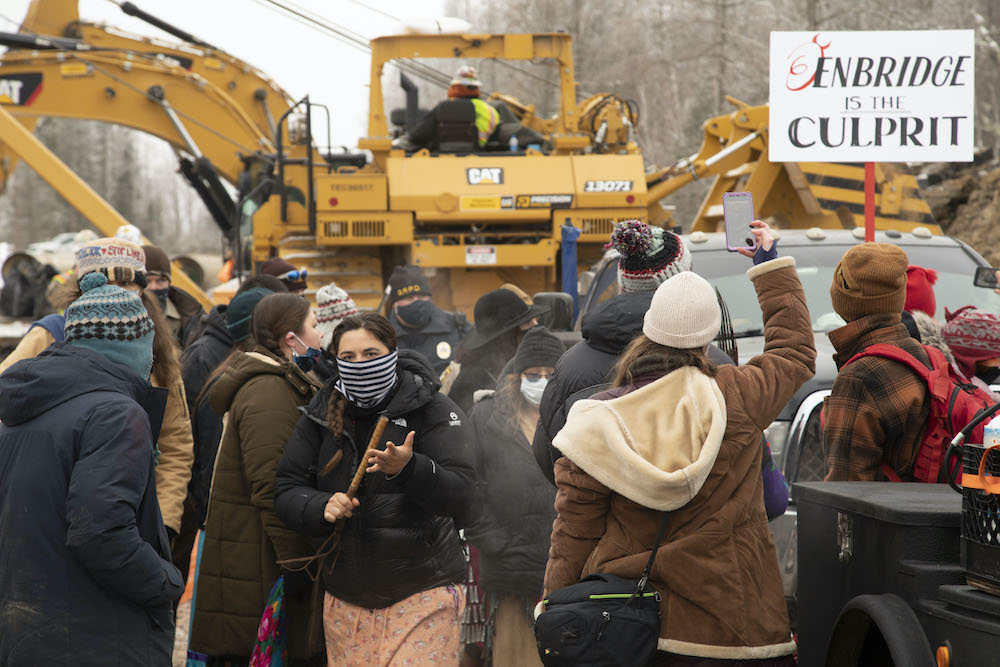
Protesters surround construction equipment used to drill a path for the Enbridge Line 3 oil pipeline near Haypoint, Minnesota, Jan. 9, 2021. (© Keri Pickett)
Editor's note: This story originally appeared at The Nation and is republished here as part of Covering Climate Now, a global journalism collaboration strengthening coverage of the climate story.

In normal times, about 100 souls live in this small Northern Minnesota town on the banks of the Mississippi River where we are making our stand against one of the largest tar sands pipeline projects in North America. Known as Line 3, it has the potential to carry 915,000 barrels a day of dirty oil over 1,000 miles, from Alberta in Canada to Superior, Wisconsin. Palisade is the kind of place where most people know one another a couple of generations back, a town with a tiny main street and just one café. Now there are about 400 workers here — most from out of state — rolling heavy trucks and equipment down icy, windy unfamiliar roads every day.
This small town is nestled in the deep woods and muskegs of Aitkin County, the lands of the Chippewa of the Mississippi, as my people are known. Akiing, the Anishinaabe word for "the land to which the people belong," is half land and half water. Waters deep and shallow filled with wild rice, sturgeon and muskies, and all the mysteries of the deep waters. This is the only place in the world where wild rice grows. Each year in succession the manoomin returns, the only grain native to North America. This is the homeland of the Anishinaabe.
And here Enbridge, the largest pipeline company in the world, is hell-bent on jamming through their Line 3 Pipeline, the company's most massive project, under the cover of this COVID-19 winter as fast as they can—before we can stop them and before the world takes notice.
From the Water Protector Center at the edge of the pipeline route, Water Protectors gather. We hear the pounding all day long. The constant roar of heavy machinery as it rips through the forest and the wetlands. It's brutal work, and dangerous as hell. Last month, Jorge Lopez Villafuerte was killed in the Enbridge Pipeyard, run over by a forklift. He came here from Utah for work. Instead, he found death. Enbridge halted work in the area for less than four hours — and then the pounding began again.
Then there's the armed forces, the sheriff's office, and the Minnesota Department of Natural Resources (DNR) who have deployed here. Their wages are paid by Enbridge. That's because Minnesota noted the $38 million bill for Standing Rock, and decided just to pay in advance. A Canadian corporation paying for the police in Minnesota.
Minnesota needs real infrastructure: water, sewer and bridges. But we're getting a climate bomb pipeline instead.
It looks like an occupation. It feels like an occupation. With all the violence that entails.
First the big dozers came, then the excavators, backhoes and feller bunchers. That last one just sort of walks through the forest, beheads a tree, drops the top to one side, and then comes back for the rest of the tree. This is how Enbridge rolls through a forest. They are gunning for the rivers now, heading straight for them: the Mississippi, the Willow, the Shell, the Little Shell, the Crow Wing: 22 river crossings in all. They are coming with something called a High Directional Drill. So they can drill under the river, just like they did at Standing Rock, at the Cannonball River. It feels a lot like a rape.
They don't want us to see what they are doing. Last week, they put up a fence around the drill site. They plan to shove in that 36-inch pipe, so it can move 915,000 barrels a day of the dirtiest oil in the world across 330 miles of Northern Minnesota to Lake Superior.
We have been fighting this pipeline for seven years. And so far we've held it off in the courts and through the permitting process. The carbon output would be equivalent to opening 50 new coal plants—more carbon emissions than the entire current Minnesota economy. And all this for a dying industry. Energy companies and investors are fleeing the tar sands. Keystone XL is doomed, Dakota Access is in a legal mess (federal courts have ruled that its Environmental Impact Statement is inadequate). Enbridge itself is putting 400,000 barrels a day less through its main lines than they did a year ago. But the company still wants to sell this last pipeline. The Last Tar Sands Pipeline. Our governor, Tim Walz, took the bait. Minnesota needs real infrastructure: water, sewer and bridges. But we're getting a climate bomb pipeline instead.
Enbridge would like to start flooding the north country with oil, as quick as it can. The Red Lake and White Earth tribes and even the Minnesota Department of Commerce have filed suit in state courts to overturn all the permits on this pipeline. On Christmas Eve, we filed in federal court to overturn the Army Corps of Engineers' permits to cross the rivers. There has been no federal Environmental Impact Statement. We have a pretty good chance of prevailing in court. So Enbridge wants to finish this dirty work before the law comes.
Advertisement
On the bank of the Mississippi in the pathway of the pipeline, there is a prayer lodge, a waaginoogan, a ceremonial teaching lodge, and we have been praying there. We've built lodges like this on the shores of the river for generations. We built the lodge before Enbridge.
A couple of weeks ago, my friend Tania Aubid and I returned to our lodge and found a stake in it, an Enbridge pipeline right-of-way stake. That was a surprise. One of the conditions of Enbridge's permits is that they are supposed to have cultural monitors out ahead of the pipeline. But of course they didn't. They just put a stake in the middle of the lodge. The Minnesota Department of Natural Resources issued an "exclusion order" on Dec. 5, excluding Minnesotans from public lands they had given to Enbridge. That's public lands, handed over to a Canadian corporation. I was cited by Aitkin County for trespassing, as I left my lodge. We contend that our spiritual practice, guaranteed by the American Indian Religious Freedom Act, supersedes the ordinance. The Creator gave us a right to pray, not Minnesota. We put up a "No Trespassing" sign with the American Indian Religious Freedom Act cited on it — USC 42. The lodge is still there. And so are we.
And not just in Palisade. Indigenous people and our allies are resisting across the whole pathway of this pipeline, from near the Red Lake Reservation in the Northwest, where a new camp just opened, to the Fond du Lac reservation on the eastern end, where Water Protectors have been disrupting the destruction everyday. This past month we've been praying by the river, and asking others to come. And they have answered the call: legislators, friends from the cities, people of all religious faiths, relatives from South Dakota, Iowa, Illinois, water protectors from all four directions to sing those Water Songs, as Enbridge drills.
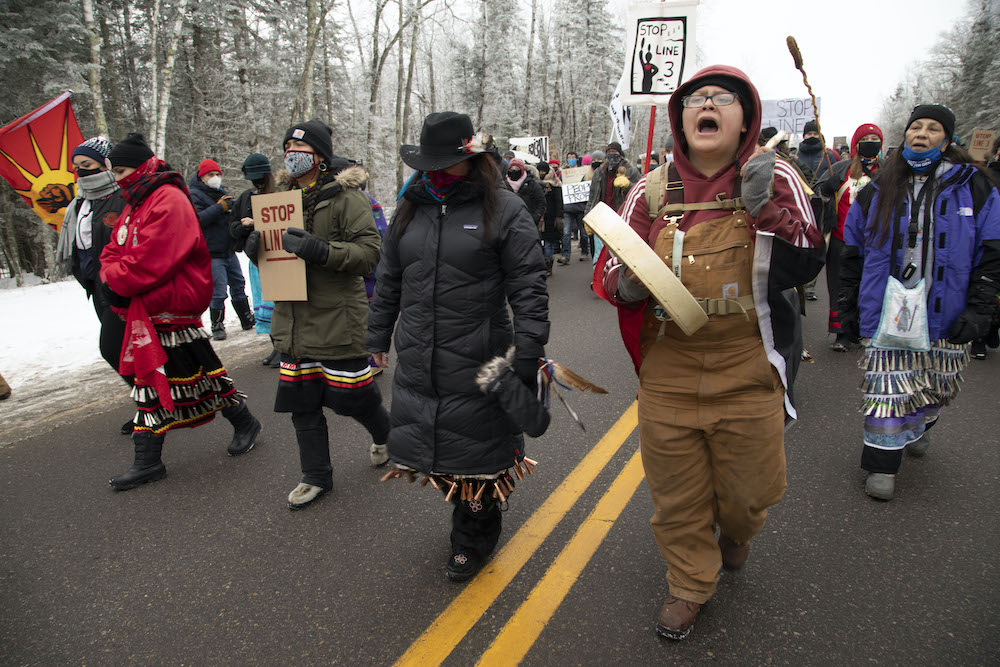
Indigenous water protectors protest construction of the Enbridge Line 3 pipeline near Palisade, Minnesota, Jan. 9, 2021. (© Keri Pickett)
When the pipeline project was one month in, 44 people already had been arrested. Forty-four good people who put their bodies on the line because they believe in water more than oil. And more are coming every day.
We are digging in for the winter. After all, we've got good genes and warm clothes, and being outside during the pandemic is a good idea. But, really, we are looking to Washington now. This is the Pandemic Pipeline Project, and it shouldn't happen. It's the end of the tar sands era, and it's time for a just transition. A new president says he will take action on climate change; the Army Corps of Engineers needs to do an environmental impact statement; and we want the court to stay the project, so we can have our day in court. In the meantime, the movement grows, to stand for the water.
Learn more at stopline3.org.
[Winona LaDuke, executive director of Honor the Earth, is an economist, environmentalist, activist, hemp farmer, author, and former Green Party vice presidential candidate with Ralph Nader. She lives on the White Earth reservation in northern Minnesota.]


